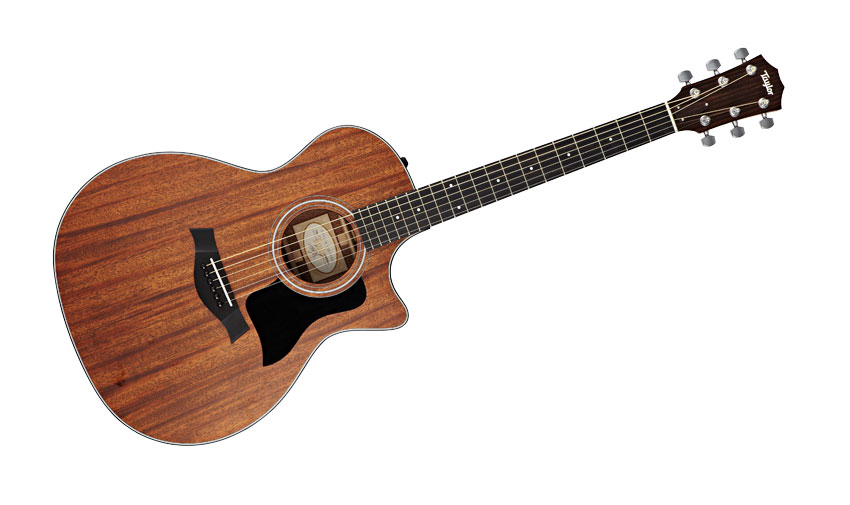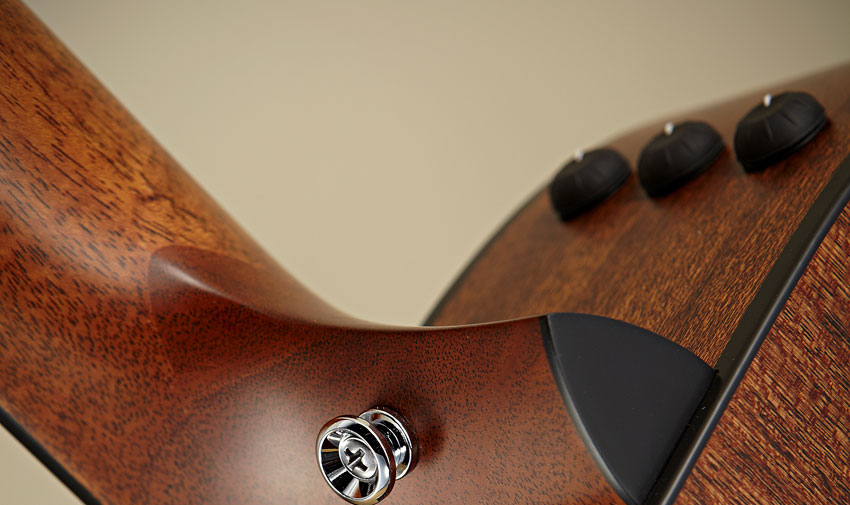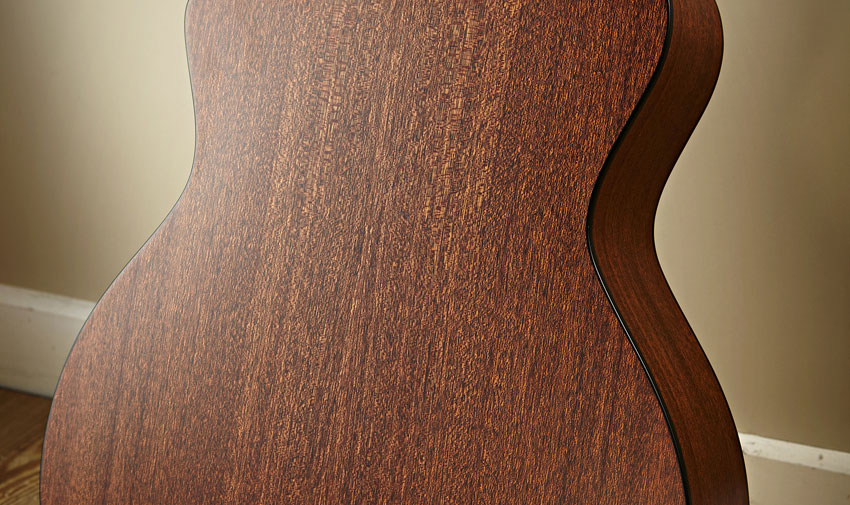MusicRadar Verdict
The 324ce gives a mahogany flavour and aesthetic - alongside a rock solid, playable build - at a reasonable price.
Pros
- +
Great playing and sounding, professional working instrument. Different voice.
Cons
- -
Won't appeal to traditionalists.
MusicRadar's got your back

Taylor 324ce

Neck heel

Rear
This year sees the first time that Taylor has used mahogany in the standard 300 series, pairing it with the mahogany-alike sapele on the guitars' backs and sides. Here we look at one such example, the Grand Auditorium 324ce.
"The guitar looks very workmanlike, not least with its 'hog top'"
The guitar looks very workmanlike, not least with its 'hog top'; the 324ce's all-over satin actually looks just as classy to our eye as the glossed bodies of the pricier 500 series.
Construction-wise, the 324ce goes for a dot-inlaid 'board and unbound rosewood-faced headstock, and its widely spaced soundhole rings are simply black and white plastic. The 324ce's 'board is bound, although it's black plastic, which is used for the body binding and heel cap.
There's a very electric-like feel to the neck - in a good way. It's consistently shaped with a subtle V to the profile that really loses the shoulder and almost fools your hand into thinking it's a thinner neck than it really is.
Straight from the case, it's road-ready with fast but not ultra-low action. The Tusq nut and compensated saddle ensure spot-on intonation, and inside and out there's nothing to criticise.
This 324ce also has Taylor's slightly upturned round-nosed Florentine cutaway, too (an order-only option in the 300 series), and of course, Expression System electronics with those low profile rubber controls on the upper shoulder for volume and centre-notched treble and bass.
Sounds
As a reference, Taylor provided us with a spruce-topped 514ce, which is a good place to start our listening test. There's that instantly recognisable modern 'produced' acoustic sound: crystal clear complex highs, seemingly scooped midrange and piano-like lows that, with the mahogany back and sides, never sound quite as 'hi-fi' as rosewood.
"If you don't want to stray too far from your spruce top, this would be a good option"
The 324ce, with its sapele back and sides, sits midway between our reference guitar and the recently reviewed all-mahogany 526ce. There's certainly some of the 526ce's power, but it sounds more open in the midrange. If you don't want to stray too far from your spruce top, this would be a good option, whereas the 526ce offers much more of a tonal contrast.
Like any acoustic pickup system, Taylor's Expression System has its fans and detractors. In some scenarios, the lack of onboard control - volume, treble and bass rotaries aside - can be an issue, so if you need more control (feedback rejection, additional EQ and, of course, a tuner) you'll have to do that outboard. With that caveat, the ES produces an excellent 'all-round' electro tone. There's a hint of Fisman's Rare Earth 'magnetic' tonality, but plenty of modern sizzle, too.
You can also switch the body sensor off via a switch accessed through the soundhole, leaving just the sensor that's buried in the neck joint active. It proves handy to sort some feedback issues, but in most of the acoustic settings in which we've used Taylors, feedback seems under control and it might be more of a style/sound choice - the body sensor obviously adds more complexity and 'realism' to the sound, and the neck pickup alone sounds a little older. Importantly, you have a choice that's rarely offered by other mainstream makers.
The output seems lower than some under-saddle systems, so swapping guitars can be an issue live. But sonically, like everything else about a Taylor, it's a thoroughly pro system. We hear through the grapevine that there will be revisions to the ES in 2014, but we'd still be very happy to step on the boards with any of these guitars.
Also, for those of us recording at home where it's not always possible to use a mic, the ES is excellent direct in: very clean and balanced.
As one of the world's largest and most consistent makers, when Taylor does something it's usually for a reason. The inclusion here, then, of mahogany tops to its key ranges might seem a cynical bandwagon-jumping exercise - until you hear one.
The more fundamental punchy voicings of this 'hog top', makes it sonically a very viable different voice - and one that's most welcome.
Dave Burrluck is one of the world’s most experienced guitar journalists, who started writing back in the '80s for International Musician and Recording World, co-founded The Guitar Magazine and has been the Gear Reviews Editor of Guitarist magazine for the past two decades. Along the way, Dave has been the sole author of The PRS Guitar Book and The Player's Guide to Guitar Maintenance as well as contributing to numerous other books on the electric guitar. Dave is an active gigging and recording musician and still finds time to make, repair and mod guitars, not least for Guitarist’s The Mod Squad.
“We were arguing a lot and we were miserable”: How Green Day exceeded expectations with their most ambitious song
"There’s plenty for us guitarists to learn – and ‘less is more’ is the overriding lesson": how to play like George Harrison on The Beatles' Abbey Road
“They didn’t like Prince’s bikini underwear”: Prince’s support sets for the The Rolling Stones in 1981 are remembered as disastrous, but guitarist Dez Dickerson says that the the crowd reaction wasn’t as bad as people think










